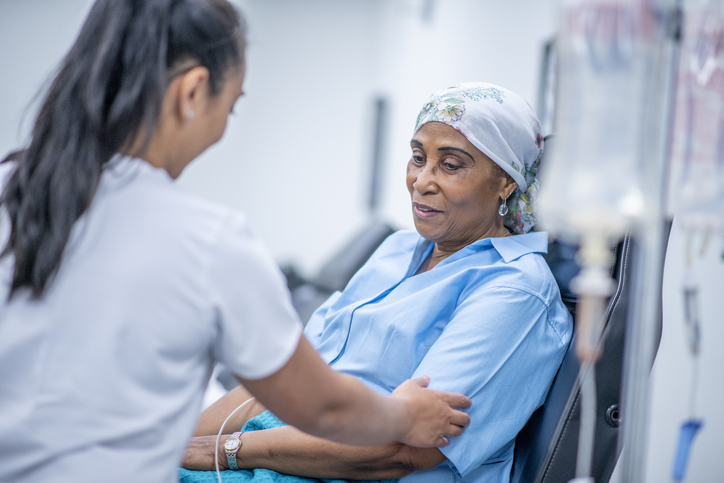
A five-year model will test ways to improve cancer care for Medicare patients while reducing costs, according to the U.S. Centers for Medicare & Medicaid Services (CMS). The Enhancing Oncology Model (EOM) places patient needs and preferences at the center of their care.
Goals of the Enhancing Oncology Model
- Provide cancer patients with high-value, evidence-based care from the cancer team — with equitable treatment across the population
- Identify methods that reduce the high cost of cancer care
- Increase engagement across patients, family, oncologists and other stakeholders in Medicare beneficiaries’ cancer treatment
- Observe improvements in quality of care, health outcomes, health equity and cost savings over the five-year term of the test
Lessons from the Enhancing Oncology Model can be applied to Medicare requirements after the EOM wraps up in 2028.
Oncology practices that volunteer for the Enhancing Oncology Model will receive incentives from Medicare if they can show they have improved patient care, reduced disparities in treatment among patients and cut the cost of delivering cancer treatment.
“The Enhancing Oncology Model will incentivize participating oncology practices – including those in rural and underserved areas – to improve the provision of high quality, coordinated care that addresses patients’ social needs and improves patient and caregiver support,” CMS Administrator Chiquita Brooks-LaSure said when announcing the EOM.
The program focuses on oncology practices providing chemotherapy to Medicare patients with common types of cancer — including breast cancer, lung cancer, prostate cancer, chronic leukemia, cancer of the small intestine, colorectal cancer, multiple myeloma and lymphoma.
How Does This Plan Affect People on Medicare with Cancer?
The goal of the Enhancing Oncology Model is to put patients at the center of a cancer care team to better support patients and improve their care.
If your providers do participate in EOM, you should find it easier to communicate with your oncologist and the rest of your cancer care team.
Examples of Patient-Focused Services in the EOM
- Allow you to present your preferences in discussions about elements of your treatment — including prognosis, treatment options, quality of life, and other elements.
- Access to patient navigators — experts who guide you through your cancer care process and help you deal with issues that could delay or prevent you from getting the cancer care you require.
- Round-the-clock access to appropriate health care providers who have real-time access to your medical records.
- Screening for needs involving housing, food, transportation and other health-related social needs.
Source: U.S. Centers for Medicare & Medicaid Services
Medicare coverage of cancer treatment is one of its biggest expenses. And its costs for treating cancer are projected to increase from $183 billion in 2015 to $246 billion in 2030, according to a 2021 study in the Journal of the American Medical Association.
The Enhancing Oncology Model does not add to your out-of-pocket costs for cancer care. And it does not affect how much you pay for Medicare. But improving efficiencies in how cancer is treated could eventually reduce how much beneficiaries have to pay for Medicare premiums or other standard out-of-pocket costs.
But since the program is voluntary, not all health care providers — doctors, hospitals, treatment centers or other providers — may choose to participate in the five-year model.
Part of the “Cancer Moonshot” to Reduce Cancer Deaths
The EOM is Medicare’s latest efforts within the broader “Cancer Moonshot” that President Biden relaunched in February 2022 to speed up progress against cancer.
The Cancer Moonshot aims at reducing cancer deaths in the United States by at least 50% within the next 25 years.
At the same time, the Cancer Moonshot calls for improving treatment experiences for cancer patients and survivors along with their families. This is a key part of Medicare’s Enhancing Oncology Model.
“EOM aligns with the Cancer Moonshot pillars and priorities of supporting patients, caregivers, and survivors, learning from all patients, targeting the right treatments for the right patients, and addressing inequities,” according to a CMS fact sheet released at the announcement.
How the Enhancing Oncology Model Will Work
The Enhancing Oncology Model is what Medicare calls a value-based program. These programs incentivize health care providers who find ways to improve patient care and outcomes while reducing overall costs to Medicare.
Goals of Medicare Value-Based Programs
- Better care for individual patients
- Lower costs to taxpayers and Medicare beneficiaries
- Better health for populations
Source: U.S. Centers for Medicare & Medicaid Services
“The Enhancing Oncology Model will incentivize participating oncology practices – including those in rural and underserved areas – to improve the provision of high quality, coordinated care that addresses patients’ social needs and improves patient and caregiver support,” CMS Administrator Chiquita Brooks-LaSure said.
The EOM features specific elements designed to reach the overall goals of better health and treatment — at lower costs — to health care providers who are required to meet certain standards.
Elements of the Enhancing Oncology Model
- Providers consider the whole patient
- Providers proactively engage with patients during and between appointments
- Patients have 24/7 access to care, care planning, patient navigation and other elements of their treatment
- Providers must report patient demographics — race, gender identity, ethnicity, language — to CMS to monitor patient disparities
- Providers must create plans that demonstrate how they will address any health care disparities among their patient population
CMS will use detailed reports from the health care providers to monitor how the EOM is working.
Health care providers who take part in EOM are responsible for the total cost of care during their first six months of providing care to patients. After that, they will either get incentive payments from CMS or must return money to CMS based on the quality of their performance.